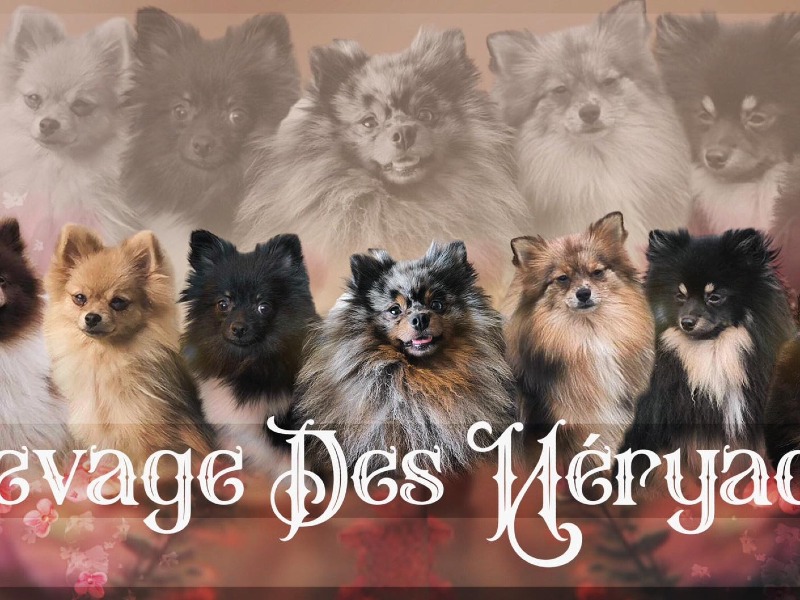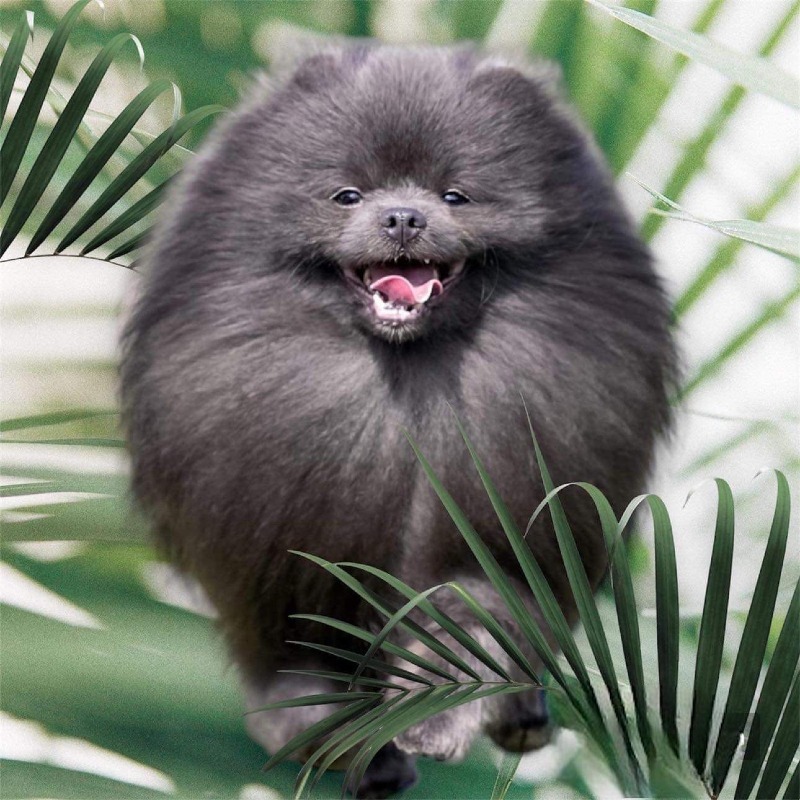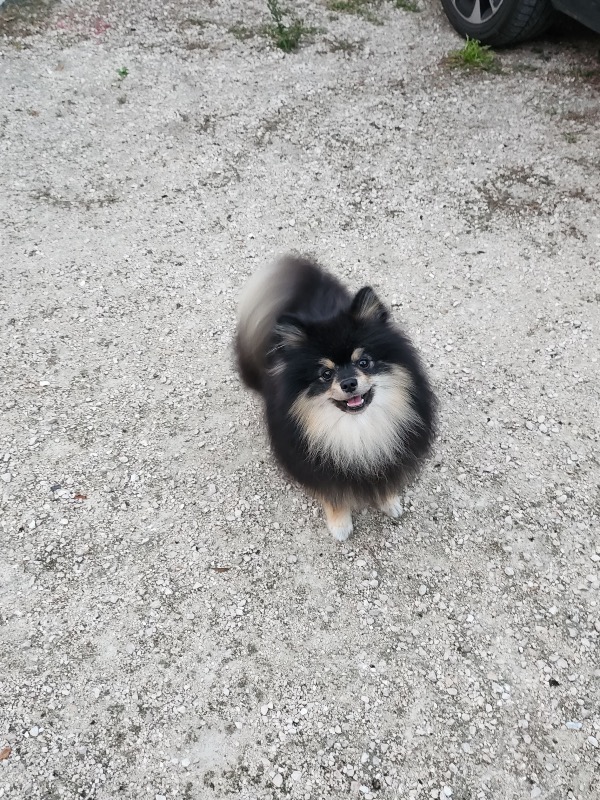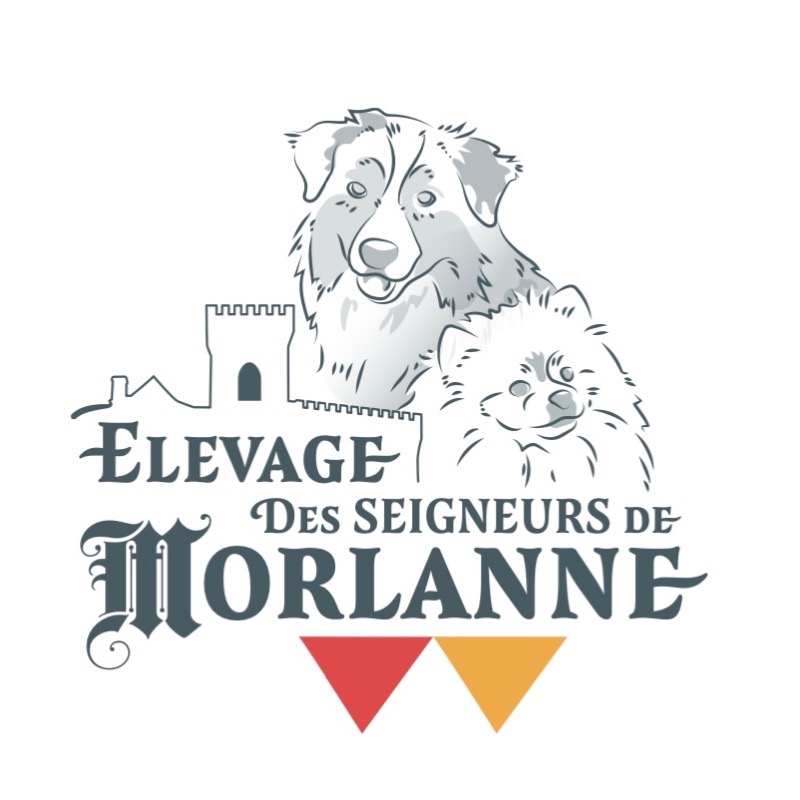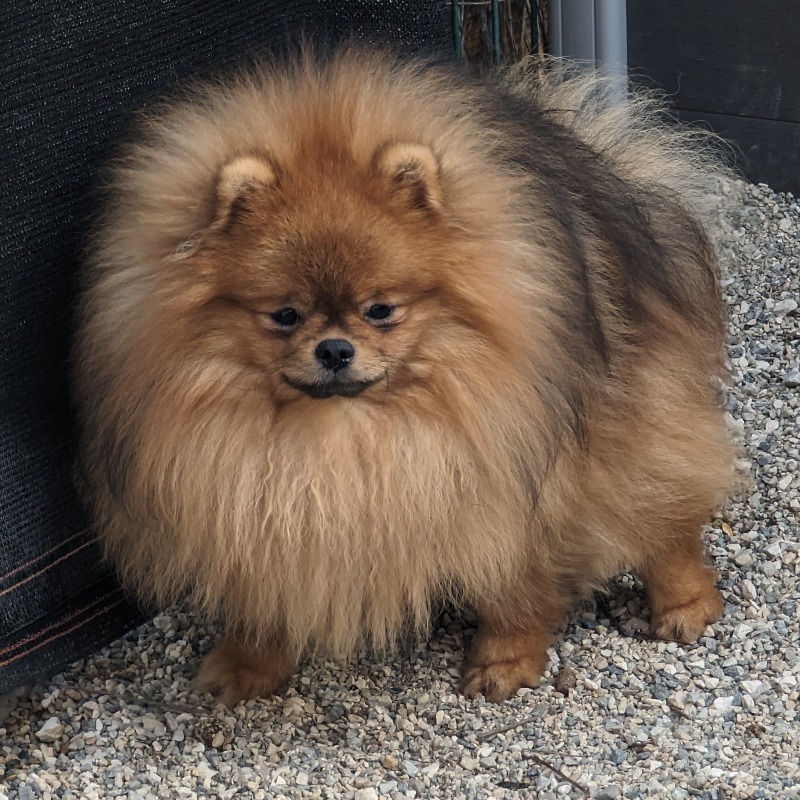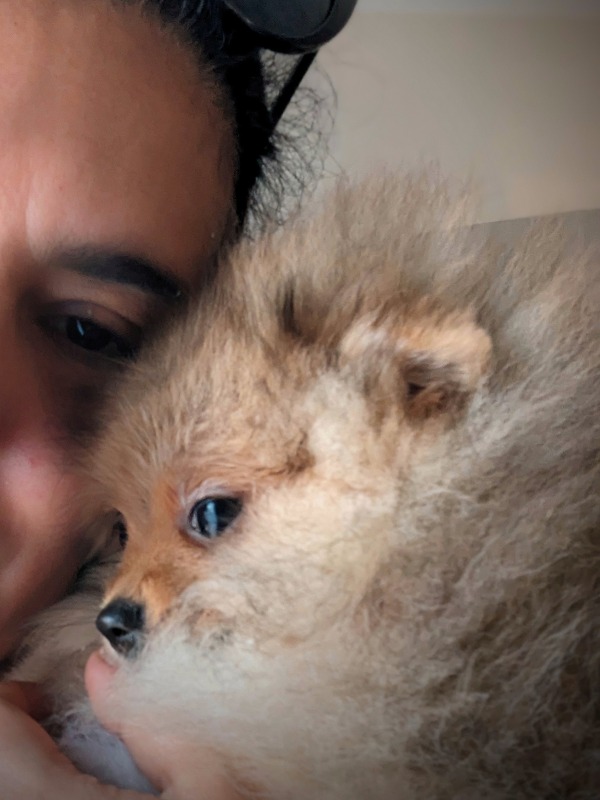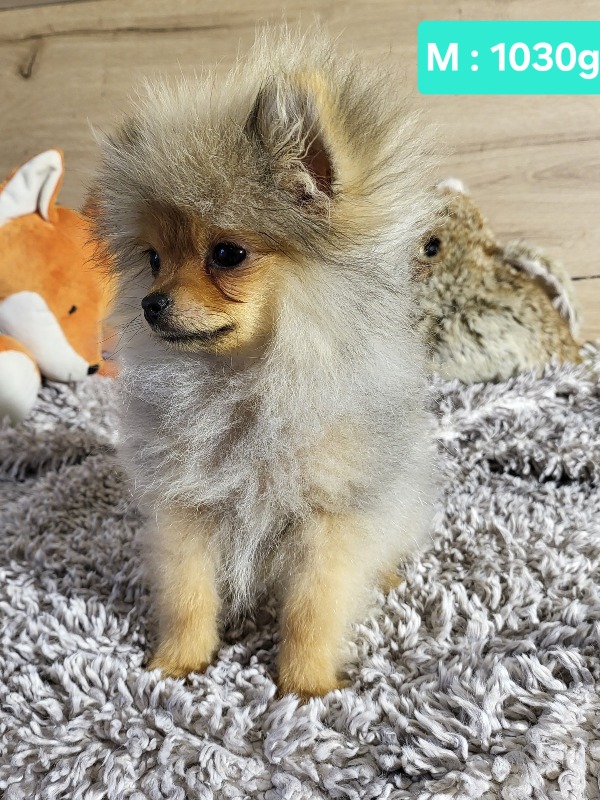German spitz
Welcome to our page dedicated to the breed of dog german spitz!
Here, you will find all the useful information about german spitz. This descriptive profile will allow you to discover the aspects of this breed. You can notably consult information about the average price, monthly and annual upkeep expenses, their health, name ideas, as well as their official recognition by competent authorities.
Explore this page to discover everything you need to know.
Overall description of the breed
Originating from Germany, the German Spitz is the ancestor of numerous breeds found across the European continent. It is known to be a descendant of "marsh dogs" or "lake city dogs," two types of dogs present since the Stone Age. Primarily used as a herding dog, it wasn't until the early 18th century that the small-sized Spitz made its first appearance, resulting from a rigorous selection implemented by certain breeders to develop miniature subjects, such as the Pomeranian.
The German Spitz consists of five different varieties, including the Spitz-Wolf or Keeshond, the Medium Spitz, the Kleinspitz (small model), and the miniature version, the Pomeranian Spitz. All of these varieties are primarily distinguished by their size, as their morphological characteristics are practically identical. This small dog with an elegant appearance has sparked a real enthusiasm within the European aristocracy and bourgeoisie.
Originally of solid black or entirely white color, it wasn't until the end of the 19th century that orange-colored subjects appeared. Queen Victoria of England owning a dog of this shade quickly created a new trend within the British aristocracy.
Throughout history, this small dog with its soft coat has charmed many celebrities. Indeed, Émile Zola, Wolfgang Amadeus Mozart, and even Queen Marie-Antoinette (wife of King Louis XIV) were once the happy owners of a medium-sized or small German Spitz.
The breed was officially recognized by the FCI on January 1st, 1957, and we note the recent update of its standard by the breed club on September 4th, 2019.
Despite its delicate appearance, this dog is remarkably robust. Its body is short and compact, with a fine and deep head, presenting a well-rounded and fairly wide dome. The head tapers towards the muzzle, and in miniature versions, a pronounced stop is appreciated, while in larger models, the stop is less defined.
Its small ears are upright at the top of the head, and its tail in a semi-circle falls along its back. This little ball of fur has abundant and fluffy fur, denser on the tail and around the ruff. The most classic coat colors are black, white, cream, and red, although unrecognized shades exist nowadays.
The German Spitz is particularly affectionate and tender towards its owners, as centuries of closeness with humans have created strong bonds. However, it remains wary of strangers and excels as a good guardian, not hesitating to warn in case of danger.
Its docile temperament facilitates training, and its high intelligence makes it a quick learner. Very attached to its masters, it often maintains a deep bond with them, making it intolerant of prolonged absence from its family, which it loves unconditionally. Endearing and dynamic, it greatly enjoys sports activities and agility courses, always eager for new activities.
In conclusion, regardless of its size, thanks to its loyalty and gentleness, the German Spitz will bring happiness to both small and large individuals.
As an adult, the Spitz weighs on average between 3 and 20 kg, depending on the variety, and its shoulder heights are as follows:
Spitz-Wolf/Keeshond: 49 cm (19.3") ± 6 cm (± 2.3").
Large German Spitz: 45 cm (17.5") ± 5 cm (± 2").
Medium German Spitz: 35 cm (13.7") ± 5 cm (± 2").
Small German Spitz: 27 cm (10.6") ± 3 cm (± 1.1").
Dwarf/Pomeranian German Spitz: 21 cm (8.2") ± 3 cm (± 1.1").
Awareness of acquiring an animal
Each animal is a sensitive being, deserving love, attention and care.
When you choose to adopt an animal, you take on the responsibility of ensuring its health and well-being throughout its life.
To learn more about animal welfare, we invite you to consult our FAQ by clicking the button below:
Origins
The German Spitz, also known as Deutscher Spitz, is an ancient dog breed originating from Germany. Its origins date back several centuries, with ancestors that were used as guard and herding dogs in rural regions of Germany. The breed is part of the larger family of Nordic dogs, characterized by their thick coat and fox-like appearance. The German Spitz is known for its great adaptability and intelligence, making it an excellent companion in various situations, from family homes to farms and urban environments.
History
The history of the German Spitz is rich and ancient. This dog descends from the bog dogs of the Stone Age, one of the oldest dog breeds in Central Europe. Over the centuries, these dogs have been bred for their versatility and ability to adapt to different roles, including guarding, hunting, and companionship. In the 19th century, the breed gained popularity among European nobles, leading to standardization of the breed. Today, the German Spitz is appreciated not only in Germany but also worldwide for its alert character and distinctive beauty.
Standard
The standard of the German Spitz breed describes a dog of medium to small size, well-proportioned and elegant. The head is wedge-shaped, with pointed and erect ears. The eyes are medium-sized, almond-shaped, and express liveliness and intelligence. The neck is well-carried, and the body is compact with a straight back and deep chest. The tail is carried curled over the back and well-covered with fur. The coat is double, with a dense undercoat and a long, straight outer layer. The breed standard emphasizes balanced proportions and an overall appearance of liveliness and elegance.
Physical characteristics
The German Spitz comes in five size varieties: Wolfspitz (50 cm at the withers), Giant Spitz (42 cm), Medium Spitz (34 cm), Small Spitz (26 cm) and Dwarf Spitz or Pomeranian (20 cm). The coat is long, straight and separated from the body, with a dense undercoat. Accepted coat colors are varied: white, black, brown, orange, wolf gray, and other combinations. Their curled and well-furnished tail is characteristic, as well as their pointed ears and alert expression. German Spitz dogs are robust and elegant, with a proud demeanor and a striking presence.
Character
The German Spitz is known for its sharp wit and alert demeanor. It is proud, courageous, and full of life. Although it is loyal to its family, it can be wary of strangers, making it an excellent watchdog.
Life expectancy
The German Spitz is known for its cheerful, lively and loyal temperament. These dogs are extremely attached to their family and enjoy participating in household activities. They are naturally cautious of strangers, making them excellent guard dogs. Their intelligence and liveliness make them easy to train, but they can also be independent and sometimes stubborn. German Spitz are generally good with children and get along well with other animals if they are socialized from a young age. Their playful nature and constant curiosity make them very entertaining and affectionate companions.
Exercise and activity needs
German Spitz are energetic dogs that require regular exercise to maintain their physical and mental health. They enjoy daily walks, play sessions, and stimulating activities such as ball games or agility. While they can adapt to apartment living, they need enough time outdoors to expend their energy. Exercise sessions should be varied to prevent boredom and avoid destructive behaviors. In addition to physical exercise, German Spitz also benefit from mental stimulation, such as interactive toys and regular training sessions to keep their minds sharp and alert.
Recommended diet
The diet of German Spitz dogs should be balanced and tailored to their size, age, and activity level. High-quality food, such as specially formulated kibble or wet food for small to medium-sized dogs, is recommended. Portions should be controlled to avoid overweight, a common issue in small dogs. The monthly cost of food for a German Spitz can range from 30 to 60 euros, depending on the quality of the chosen food. It is also important to supplement their diet with healthy treats and ensure constant access to fresh, clean water.
Training and obedience
The education and training of German Spitz dogs should begin at a young age to establish good habits and reinforce desired behaviors. Their intelligence and desire to please generally make them easy to train, although they may sometimes show independence. Positive reinforcement techniques, such as rewards and encouragement, are particularly effective. It is important to socialize German Spitz dogs from a young age to get them used to different environments, people, and other animals. Regular training sessions and mental stimulation will help maintain their sharp mind and prevent unwanted behaviors.
Behavior with children
German Spitz are usually good with children, especially if they are socialized from a young age. Their joyful and playful nature makes them great playmates for children. However, due to their small size, it is important to teach children to handle dogs gently and respectfully to prevent accidental injuries. Interactions between children and dogs should always be supervised to ensure the safety of everyone. With proper socialization and adequate supervision, German Spitz can become affectionate and protective family members.
Compatibility with Other Animals
German Spitz, when properly socialized, can get along well with other pets. Their lively and curious nature generally makes them friendly with other dogs and even cats. It is crucial to introduce them gradually and in a controlled manner to new companions to avoid any aggressive or territorial behavior. German Spitz tend to adapt well to environments where they are not left alone for long periods, as they enjoy companionship. Early and continuous socialization is essential to ensure a harmonious cohabitation with other pets.
Grooming needs
German Spitz dogs require regular grooming to maintain the beauty and health of their thick double coat. Daily brushing is recommended to prevent knots and tangles, especially during shedding periods. A bath should be given every two months or as needed, using a dog-appropriate shampoo. Ears should be checked and cleaned regularly to prevent infections, and nails should be trimmed periodically. Dental care is also important in preventing oral problems. Regular grooming helps to keep the skin and coat healthy, while strengthening the bond between the dog and its owner.
Health
German Spitz are generally robust and enjoy good health, but they can be prone to certain specific health problems. Among the common conditions are luxating patellas, dental issues, and hip dysplasia. It is essential to make regular visits to the veterinarian for health check-ups and vaccinations. A balanced diet and regular exercise also help maintain their good health. Owners should be attentive to signs of illness and consult a veterinarian at the first symptoms. With proper care, German Spitz can live a long and healthy life.
Average price
The average price of a German Spitz can vary depending on several factors, including the reputation of the breeder, the lineage, and the quality of the dog. Generally, the cost of a German Spitz ranges between 800 and 2500 euros. Show dogs or those from prestigious lineages may reach higher prices. In addition to the initial cost, it is important to budget for veterinary care, food, grooming, and accessories. Prospective owners should make sure to choose a responsible breeder who conducts health tests on their dogs and raises the puppies in good conditions.
Expenses
Monthly expenses for a German Spitz can vary depending on several factors, including food, veterinary care, grooming, and accessories. On average, monthly costs can be estimated between 50 and 100 euros. This amount includes food (30 to 60 euros), preventive veterinary care, grooming products, and toys. Additional expenses may include training classes, caretaking or walking services, and boarding fees for extended absences. Adequate financial management and planning are essential to ensure the optimal well-being and maintenance of your German Spitz.
Name ideas
Choosing a name for your German Spitz can be a pleasant and meaningful task. Here are some name suggestions that may suit a German Spitz: Luna, Max, Bella, Rocky, Daisy, Leo, Ruby, Teddy, Milo, Zoe. These names often reflect the cheerful and lively personality of this breed. When choosing a name, it is important to consider the sound and simplicity of the name to facilitate learning by the dog. A well-chosen name can strengthen the bond between the dog and its owner and reflect the distinctive characteristics of the German Spitz.
Legislation and regulation
In France, German Spitz dogs must be registered in the LOF (French Book of Origins) to be officially recognized as purebred dogs. They are not classified in a category requiring special permits, unlike some breeds considered dangerous. Owners must comply with general rules for dog ownership, such as identification by microchip or tattoo, mandatory vaccinations, and compliance with local regulations on animal ownership. It is also advisable to take out civil liability insurance to cover any potential damage caused by the dog.
Official recognition
The German Spitz is recognized by several national and international organizations. In France, it is recognized by the Société Centrale Canine (SCC) and registered in the LOF (Livre des Origines Français). At the international level, the Fédération Cynologique Internationale (FCI) recognizes the German Spitz under group 5, section 4 (European Spitz). In the United States, the breed is recognized by the American Kennel Club (AKC) and in the United Kingdom by the Kennel Club (KC). These organizations establish breed standards and organize dog shows where German Spitz can compete. Official recognition ensures that dogs meet specific quality standards and facilitates their participation in competitions and breeding programs.
Pedigrees
German Spitz dogs have well-documented pedigrees thanks to several breed clubs and associations. In France, dogs can be registered with the Société Centrale Canine (SCC) and entered in the Livre des Origines Français (LOF). In Germany, the breed is managed by the Verein für Deutsche Spitze (German Spitz Club). In the UK, the Kennel Club keeps detailed pedigree records. In the US, the American Kennel Club (AKC) maintains detailed archives. These clubs play a crucial role in preserving pure bloodlines and promoting the Anglo-European in the international equestrian world.
Destination and usage
The German Spitz is a versatile dog that excels in many activities. Traditionally used as a guard and herding dog, it is now mostly appreciated as a companion dog. Thanks to its intelligence and energy, the German Spitz can also shine in canine sports such as agility, obedience, and canicross. Their vigilant nature makes them excellent guard dogs, while their affection and devotion make them ideal family companions. Whether for companionship, competition, or protection, the German Spitz easily adapts to various roles.
Prohibitions
There are no specific prohibitions concerning German Spitz. However, as with all breeds, owners must comply with general animal welfare laws and regulations in their country. Practices of cruelty, neglect, or excessive exploitation are strictly prohibited and punishable by law. In France, the protection of dogs is ensured by regulations aimed at preserving this valuable breed. Owners must also comply with transportation and quarantine standards when importing or exporting German Spitz dogs. Compliance with these regulations is essential to ensure the health and safety of dogs.
Breeders of German spitz
Want to see more breeders of German spitz?
Check out the page of our directory listing all breeders of German spitzClassified Ads of German spitz
Breed clubs of german spitz
No of german spitz breed clubs are currently registered on Preeders.
If you would like to highlight your breed club, sign up for free now and be the first to appear on this page.

